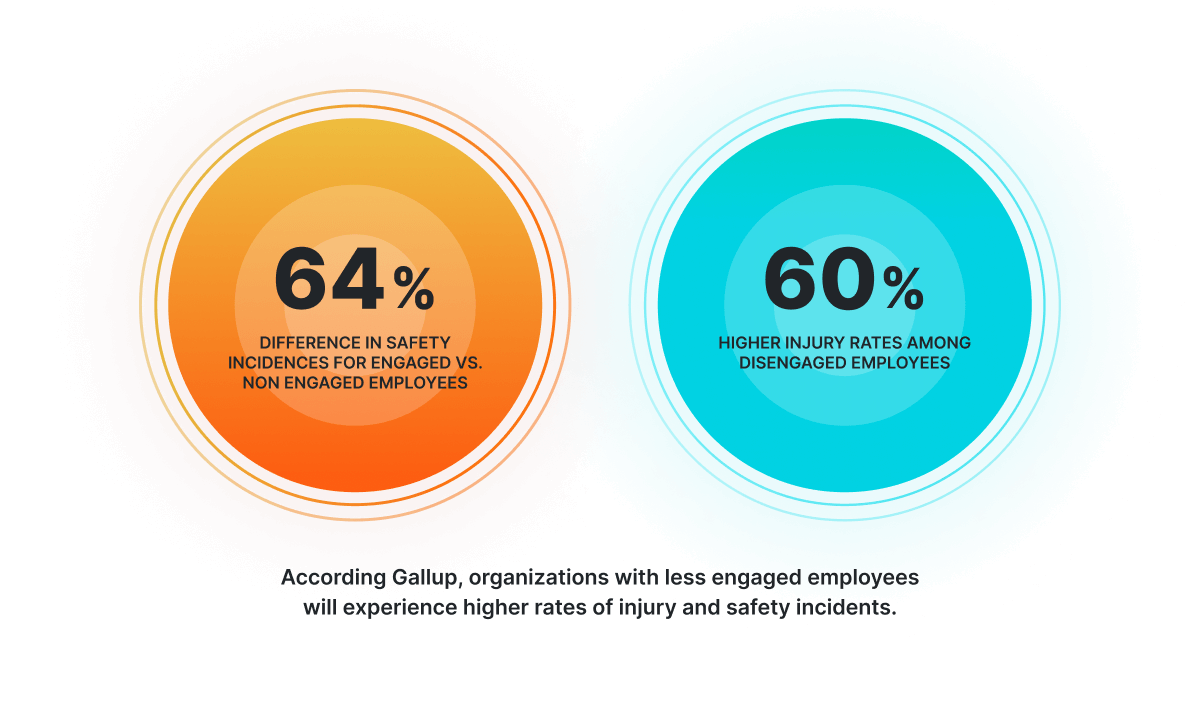Workplace safety: tips for OSHA safety compliance
Understanding the importance of workplace safety compliance
In today’s operational landscape, workplace safety isn’t just a regulatory requirement—it’s a critical factor that impacts both the financial health and the morale of an organization. The financial implications of safety incidents are stark: an average-risk company can face insurance premiums totaling up to $1,000,000 annually. These premiums are highly sensitive to incident rates, with even a modest increase potentially costing an additional $100,000 per year.
Beyond financial costs, there’s a human element to workplace safety. Employees who feel unsafe are not only at higher risk of injury but also more likely to leave their jobs. According to Safesite and Gallup, workers with negative safety sentiments are 2.75 times more likely to depart their organization within just 30 days compared to those who feel positively about safety measures.
In this blog post, we will explore how organizations can effectively navigate OSHA safety compliance challenges. We’ll discuss practical strategies to enhance workplace safety outcomes and foster a culture of safety within your organization. Join us as we delve into essential tips and best practices for achieving and maintaining OSHA safety compliance.
The financial and operational impact of non-compliance with OSHA
Understanding and adhering to Occupational Safety and Health Administration (OSHA) standards is not just a legal requirement but a critical aspect of maintaining workplace safety and operational efficiency. Non-compliance with OSHA regulations can have profound financial repercussions for businesses, impacting both their bottom line and operational continuity.
OSHA penalties
OSHA imposes penalties on employers who fail to meet safety standards outlined in Section 5 of the OSHA Act, or violate rules and orders established under Section 6. These penalties are designed to incentivize compliance and mitigate workplace hazards. The severity of penalties varies based on the nature and frequency of violations:
- Willful or Repeated Violations: Employers found to willfully or repeatedly violate OSHA regulations may face civil penalties ranging up to $70,000 per violation. Willful violations carry a minimum penalty of $5,000.
- Serious Violations: For serious violations that pose a substantial risk of death or serious injury, penalties can reach up to $7,000 per violation.
- Failure to Correct Violations: If an employer fails to rectify a cited violation within the specified timeframe, they may incur penalties of up to $7,000 per day until compliance is achieved.
- Criminal Penalties: In cases where willful violations result in employee fatalities, criminal penalties can include fines up to $10,000 or imprisonment for up to six months. Subsequent convictions can lead to fines up to $20,000 or imprisonment for up to one year.
These penalties underscore the importance of proactive safety measures and regulatory adherence. Beyond financial liabilities, non-compliance with OSHA can tarnish a company’s reputation, lead to increased insurance premiums, and disrupt business operations.
Harnessing frontline worker feedback to increase workplace safety
Collecting and utilizing feedback from frontline workers is pivotal in increasing workplace safety and operational efficiency. Frontline employees are uniquely positioned to observe daily operations and identify potential safety hazards before they escalate into emergencies. Their insights provide valuable perspectives that can inform proactive safety measures and foster a culture of continuous improvement.
Methods for gathering safety-related feedback and using it to detect and address safety issues
Effective methods for gathering safety-related feedback include regular surveys, real-time incident reporting tools, and structured check-ins throughout the workday. WorkStep’s intuitive feedback management system facilitates these processes, allowing frontline workers to report safety issues instantly and anonymously.
This streamlined communication enhances responsiveness and ensures that potential hazards are addressed quickly. Whether it’s identifying unsafe practices, malfunctioning equipment, or environmental hazards, timely feedback enables proactive intervention to reduce workplace accidents and injuries. WorkStep’s communication channels support automated alert detection and confidential 1:1 communication, enabling leaders to resolve issues in real-time before they escalate.
Benefits of workplace safety technology
Workplace safety technology, such as WorkStep’s communication tools, offers several key benefits:
- Proactive issue prevention: Predictive analytics and real-time reporting capabilities help organizations anticipate and mitigate safety risks.
- Behavior reinforcement: Communication channels reinforce safe behaviors through targeted messaging and recognition of positive safety practices.
- Confidential communication: Secure, one-on-one communication channels ensure that employees can report concerns without fear of reprisal, fostering a culture of transparency and trust.
By harnessing frontline worker feedback and leveraging advanced safety technology, organizations not only increase workplace safety but also optimize operational performance and compliance with regulatory standards.
Integrating safety practices into daily operations
Integrating safety practices into daily operations is essential for fostering a safe workplace environment. WorkStep supports this integration by delivering real-time safety updates, reminders, and public recognition of safety achievements. These tools ensure that safety protocols are seamlessly incorporated into routine tasks and operations, promoting consistent compliance and vigilance among frontline teams.
Creating a culture of safety goes beyond protocols—it involves instilling a collective responsibility for safety and encouraging employees to report unsafe behaviors they observe. WorkStep empowers employees to actively participate in safety initiatives, enhancing hazard identification and fostering a culture where safety is a top priority.
Ensuring frontline compliance with changing regulations
Staying updated with evolving OSHA regulations presents significant challenges for businesses, especially those with dynamic operational environments. WorkStep recognizes the importance of proactive compliance and offers strategies to navigate regulatory shifts effectively. By leveraging technology and continuous training programs, organizations can ensure their frontline workforce remains informed of updated safety protocols and regulatory requirements.
WorkStep’s integration with HRIS plays a crucial role in maintaining real-time compliance with regulatory changes. This seamless integration allows for the quick distribution of updated policies and procedures directly to frontline employees. By automating compliance updates through HRIS, WorkStep ensures that all safety measures are promptly implemented, reducing the risk of non-compliance penalties and promoting a culture of regulatory adherence.
Measuring employee engagement in safety initiatives
Employee engagement is pivotal to achieving safety goals within any organization. Engaged employees are not only more likely to adhere to safety protocols but also actively contribute to identifying and mitigating risks.
Public companies, mandated to report on Environmental, Social, and Governance (ESG) criteria, often include safety metrics such as incident rates and days without major safety incidents, underscoring the importance of robust safety initiatives.
Effective methods for measuring and improving employee engagement in safety initiatives include regular feedback loops and performance metrics tracking. WorkStep’s advanced employee feedback tools play a crucial role in enhancing engagement and participation in safety programs. Through intuitive surveys and real-time feedback mechanisms, WorkStep empowers frontline workers to voice safety concerns and suggestions confidentially. This engagement fosters a proactive safety culture where employees feel valued and are motivated to actively contribute to maintaining a safe workplace environment.
Improve frontline worker safety with continuous listening
Continuous listening significantly impacts organizational safety compliance by creating a dynamic feedback loop that keeps frontline safety concerns at the forefront. By enabling employees to provide real-time feedback on safety issues, platforms like WorkStep empower organizations to swiftly identify and address potential hazards. This proactive approach not only enhances safety protocols but also cultivates a culture where employees are actively engaged in maintaining workplace safety. Continuous listening ensures that safety measures remain relevant and effective, driving compliance with regulatory standards and mitigating risks before they escalate. Ultimately, it fosters a safer work environment where employees feel heard, valued, and motivated to uphold safety standards.
Understanding the importance of workplace safety compliance is critical for every organization. Workplace safety not only ensures regulatory compliance but also directly impacts operational efficiency and employee morale. By partnering with WorkStep, organizations can implement effective strategies to enhance workplace safety and foster a culture where safety is prioritized in daily operations. Through innovative safety management solutions and proactive safety initiatives, WorkStep can help businesses achieve safety compliance and create a safer, more productive work environment. Request a demo to learn more about these solutions to elevate safety standards and empower your workforce towards a safer future.
Kayla Pimentel, | kayla@workstep.com
Kayla Pimentel serves as a Demand Generation Associate at WorkStep. Leveraging her diverse background in sales and marketing, she is enthusiastic about sharing insights about how to make the frontline a better place to work.




